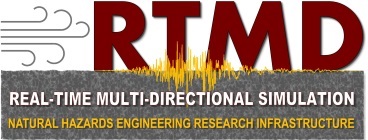Experimental Investigation of a Prototype Elastomeric Structural Damper
Project Overview
For many years, the design of seismic resistant building structures has had the goal of preventing collapse, and avoiding injury and loss of life in the event of an earthquake. More recently, seismic design practice has sought to reduce structural damage and nonstructural damage from seismic events. A variety of seismic protective systems are now utilized to reduce structural response to seismic loading.
A viscoelastic damper is a seismic protective device that decreases structural response to seismic loading (Chang et al. 1993, Fan 1998). These dampers, however, have mechanical properties which are sensitive to frequency of loading and temperature, and limit their effectiveness (Fan 1998). An elastomeric damper uses a similar material, but is less sensitive to frequency of loading and temperature (Lee 2003). However, elastomeric dampers generally provide less damping than viscoelastic dampers. This study focuses on a prototype elastomeric structural damper developed by Penn State Erie and the Corry Rubber Company, with input from researchers at Lehigh University. The damper uses a high damping elastomer pre-compressed into steel tubes, and is called the Ultra High Damped Elastomer Tube (UHDET) damper. Within this thesis, this damper is called “the prototype UHDET damper” or, more simply, “the prototype damper.” The prototype damper incorporates both elastomeric and frictional damping to increase the total damping output, and takes advantage of the low sensitivity of elastomeric materials to frequency of loading and temperature.
Summary and Conclusion
This study focused on a prototype structural damper called the Ultra High Damped Elastomer Tube (UHDET) damper. This prototype damper was developed by a team, composed of Penn State Erie and the Corry Rubber Company, with input from Lehigh University, for use in reducing seismic response in new and existing buildings.
The prototype damper is an innovative design, compared to previously developed elastomeric dampers, through the use of a pre-compressed elastomeric material within steel tubes to produce both elastomeric and friction damping output. The objective of this study was to characterize the behavior of the prototype damper under dynamic loading through experimental tests and to determine its effectiveness in reducing the seismic response of a prototype building. The scope of work to meet this objective included three tasks: (1) to conduct a performance based design study of a damped prototype building to establish behavior goals for the prototype damper, (2) to develop an experimental program based on the damped prototype building design study to characterize the prototype damper, and (3) to use the experimental results to characterize the prototype damper behavior and properties.
Based on the results of the study, several conclusions can be made:
- The prototype UHDET damper behavior is sensitive to deformation amplitude with less sensitivity to loading frequency.
- The damper stiffness decreases significantly as deformation amplitude increases.
- The damper deformation capacity in the elastic range (before slip) is very limited.
- When assumed to be half scale, the prototype dampers that were tested meet the behavior goals established from the damped prototype building study. However, a large number of dampers will need to be incorporated into the prototype building to meet the performance objectives of the design study.
- The use of the pre-compressed elastomer material within steel tubes creates a frictional behavior with a high damping output.
- The pre-compression and friction also allow the prototype damper to continue to resist force after bond failure.
- The prototype dampers tested are extremely robust. The dampers underwent numerous cycles of deformation without significant degradation of their behavior.
Sinusoidal experiment video
Participants
Graduate Research Assistant
- Angela Kontopanos – Lehigh University
Faculty Advisors
- James Ricles – Lehigh University
- Richard Sause – Lehigh University
Post-Doctoral Research Associates
- Kyung Sik Lee – Lehigh University
- Choung Yeol Seo – Lehigh University
Academic Collaborators
- Robert Michael – Penn State Erie
- Shannon Sweeney – Penn State Erie
Industry
- Corry Rubber Company


